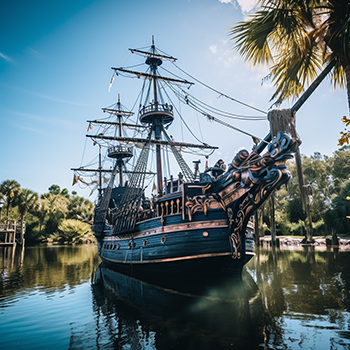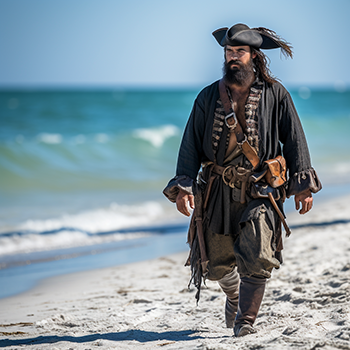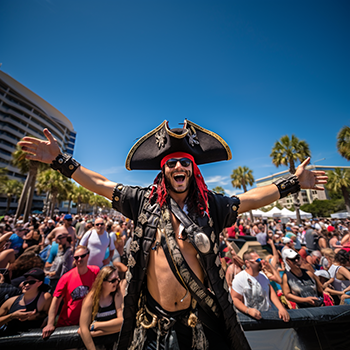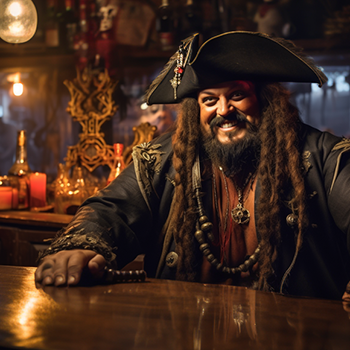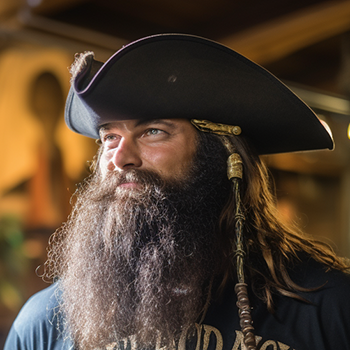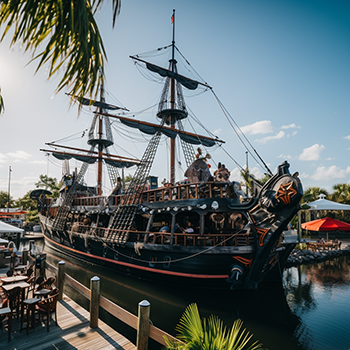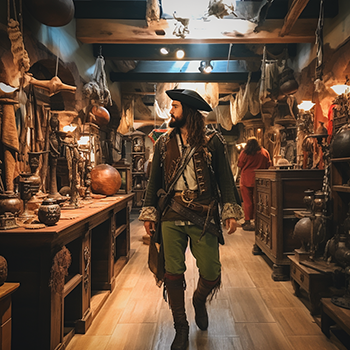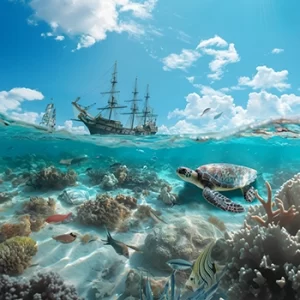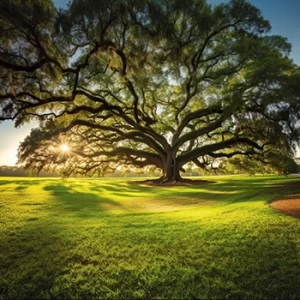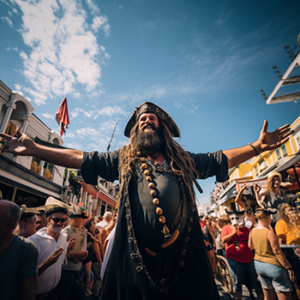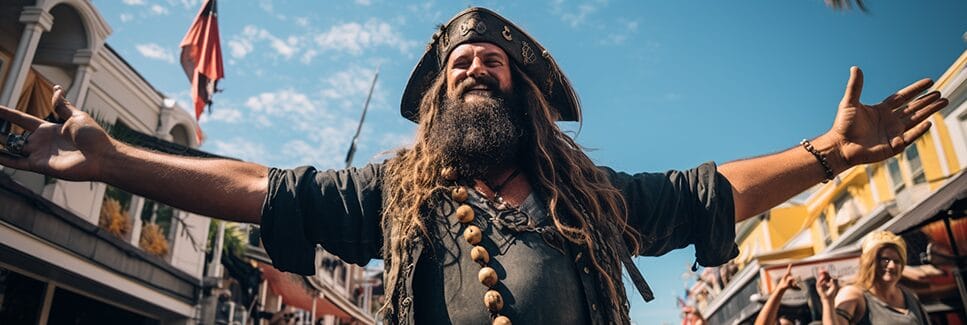
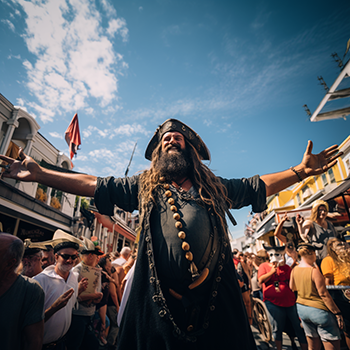
Pirates in Florida: History Meets Fun
Pirates in Florida has long been a part of this state’s history and culture. With its vast coastline and strategic location, Florida was a prime target for pirates during the Golden Age of Piracy in the 17th and 18th centuries.
Our rich pirate history has left a lasting impact on our identity, with legends and festivals, museums and culture celebrating the swashbuckling buccaneers who once roamed its waters.
In this article, we’ve got a perfect mix of Florida pirate history facts mixed with the best pirate festivals, museums and other pirate culture to enjoy in Florida!
And we list our favorite 10 pirate-themed fun things to do in Florida!

by Christa Kelly | Updated 03/09/25
Affiliate links are included in this post.
The Golden Age of Piracy in Florida
The Golden Age of Piracy is generally considered to be the period from the late 17th century to the early 18th century when piracy was at its peak.
During this time, pirates roamed the seas in search of treasure and plundered ships along major trade routes. Florida’s strategic location between the Caribbean and the Atlantic Ocean made it a prime target for pirates looking to prey on merchant vessels.
Piracy in Florida during this period was rampant, with numerous pirate crews operating in its waters.
Some notable pirates who frequented Florida included Blackbeard, Calico Jack Rackham, Jose Gaspar and Anne Bonny.
These pirates would often use Florida as a base for their operations, taking advantage of its hidden coves and secluded islands.
The Most Famous Pirate, Blackbeard, in Florida Waters
One of the most infamous pirates to operate in Florida waters was Blackbeard. Born Edward Teach in England around 1680, Blackbeard rose to infamy as one of the most feared pirates of his time.
He was known for his thick black beard and intimidating appearance, often tying slow-burning fuses into his beard and lighting them during battles to create a terrifying image.
Blackbeard’s activities in Florida waters were extensive. He would often target ships traveling along the Florida coast, capturing their cargo and holding the crew for ransom.
Jose Gaspar, Florida's Pirate
Another legendary pirate associated with Florida is Jose Gaspar, also known as Gasparilla.
According to legend, Gaspar was a Spanish nobleman who turned to piracy after being betrayed by his lover.
He became known as the “Last of the Buccaneers” and terrorized the waters of the Gulf of Mexico during the early 19th century.
Gasparilla Pirate Festival in Tampa Bay
Gaspar’s legend is celebrated every year during the Gasparilla Pirate Fest in Tampa Bay, happening annually in January.
Next Gasparilla Pirate Fest: January 31st, 2026!
For more information, check the official Gasparilla Pirate Fest website here.
The festival includes a mock pirate invasion, parades, and other festivities that pay homage to Gaspar and Florida’s pirate history.
The festival has become a major tourist attraction and has had a significant impact on Florida’s tourism industry.
The legend of Jose Gaspar has had a lasting impact on Florida’s culture and tourism industry.
His story has been immortalized in books, movies, and other forms of popular culture, further cementing his place in Florida’s pirate lore.
The Notorious Pirate Haven of Key West
Key West, located at the southernmost tip of Florida, has a long history as a pirate haven.
The island’s strategic location made it an ideal base for pirates looking to prey on ships traveling between the Gulf of Mexico and the Atlantic Ocean.
Pirates would often use Key West as a place to rest, repair their ships, and divide their spoils.
One notable pirate who operated in Key West was Captain William Kidd. Kidd was a Scottish sailor who turned to piracy in the late 17th century.
Piracy had a significant impact on Key West’s development. The island’s economy relied heavily on piracy during the Golden Age, with pirates bringing in wealth and trade.
However, as piracy declined in the 18th century, Key West’s economy shifted towards fishing and salvaging shipwrecks, which were abundant in the area.
When visiting Key West, a great place to learn more about pirates, shipwrecks and treasure is at the Shipwreck Museum.
Florida's Treasure Coast: A Pirate's Paradise
The Treasure Coast, located along Florida’s eastern coast, is known for its connection to piracy and buried treasure.
The area earned its name due to the numerous shipwrecks and treasure caches that have been discovered there over the years.
Pirates were drawn to the Treasure Coast due to its treacherous reefs and hidden coves, which provided ample opportunities for ambushes and hiding stolen goods.
Today, enjoy pirate-themed drinks and attractions, take a pirate cruise and wear cool Florida pirate t-shirts!
The Pirate Code: Rules of the High Seas
Pirates were known for their strict code of conduct, known as the Pirate Code.
This code was a set of rules and regulations that governed life on board a pirate ship, designed to maintain order and discipline among the crew and ensure fair treatment for all members.
The Pirate Code covered a wide range of topics, including division of spoils, punishment for crimes, and rules for battle.
It also outlined the rights and responsibilities of each crew member, ensuring that everyone had a voice in decision-making.
While the Pirate Code may seem archaic by today’s standards, it had a significant impact on modern maritime law.
Many of the principles outlined in the Pirate Code, such as fair treatment for all crew members and democratic decision-making, have been incorporated into modern legal frameworks.
The Impact of Piracy on Florida's Economy
Piracy had a profound impact on Florida’s economy during the Golden Age of Piracy.
Though there were threats of attacks, pirates also had a profound affect on the development of Florida’s economy.
They would sell their stolen goods to colonial merchants, who would then sell them on the open market.
Today, the economic impact of piracy is stronger than ever! Well, thankfully not the acts of piracy… but certainly the pirate-themed fun!
The state’s tourism industry, which is a major driver of its economy, has been heavily influenced by its pirate history.
Pirate-themed attractions, festivals, museums, shows and culture draw millions of visitors each year, generating significant revenue for the state.
The Pirate's Life: Food, Drink, and Entertainment on Board
Life on board a pirate ship was far from glamorous, but pirates did have their own unique culture and way of life.
Food and drink were essential for survival on long voyages, and pirates had their own preferences when it came to cuisine.
Pirates typically ate simple meals consisting of salted meat, hardtack (a type of biscuit), and dried fruits. They also drank copious amounts of rum, which was often diluted with water or mixed with citrus juice to prevent scurvy.
Entertainment was also important on board a pirate ship. Pirates would often pass the time by playing games, telling stories, or singing sea shanties.
These activities helped boost morale and maintain camaraderie among the crew.
10 Pirate-Themed Fun Things to do around Florida!
Here’s a list of 10 pirate-themed fun things to do around Florida, including museums, ships, mini-golf, dinner shows, and more:
St. Augustine Pirate & Treasure Museum: Immerse yourself in real Florida pirate history at this fascinating museum.
Learn about the notorious pirates who once roamed Florida’s waters, see real pirate artifacts, and even take a peek into a recreated pirate shipwreck.
Visit the St. Augustine Pirate & Treasure Museum website for hours of operation and directions here.
Pirate’s Dinner Adventure (Orlando): Enjoy a swashbuckling good time at this dinner theater in Orlando.
Watch a live show featuring pirates, mermaids, and acrobats, all while enjoying a delicious meal.
Visit the Pirate’s Dinner Adventure website for more info here.
Pirate’s Cove Adventure Golf (3 locations): Putt your way through a pirate-themed mini-golf course in Orlando, Ormond Beach or Kissimmee.
This fun activity is perfect for all ages and is a great way to cool off on a hot Florida day.
For all locations and hours of operation, visit the Pirate’s Cove Adventure Golf website here.
Gasparilla Pirate Fest (Tampa Bay): Every January, Tampa Bay comes alive with the Gasparilla Pirate Fest, a massive pirate festival that features a parade of pirate ships, live music, food, and drinks.
Visit the official Gasparilla Pirate Fest website to help plan your visit here!
Captain Memo’s Pirate Cruise (Clearwater): Set sail on a pirate adventure cruise in Clearwater Beach. This family-friendly cruise features a pirate show, treasure hunt, and water games.
Get more information or make reservations on the official Captain Memo’s Pirate Cruise website here.
Black Raven Adventures (St. Augustine): Enjoy pirate ship cruises in St. Augustine with unique experiences, featuring live entertainment, including pirate sword fighting, rum runners, and more.
See all the options on the Black Raven Adventures website here.
Pirate’s Pub and Grub: This waterfront restaurant in located on John’s Pass Boardwalk on Madeira Beach. It offers a fun pirate atmosphere where you can enjoy a casual seafood menu and outdoor seating.
Pirate Haus Inn: This pirate-themed hostel-style inn, located in downtown St. Augustine, offers an affordable place to sleep while exploring the area.
They offer a fun and festive atmosphere, along with delicious food and drinks. Find more information about the Pirate Haus Inn here.
Corner Copia Gift Shop (Fernandina Beach): Pirate-themed gift shop in North Florida featuring plenty of pirate hats and trinkets and costume pieces, plus lots of Florida souvenirs, beach toys, sunglasses and more!
Find directions and hours of operation on the Corner Copia Gift Shop facebook page here.
Mel Fisher Maritime Museum (Key West): This museum in Key West is home to the world’s largest collection of Spanish shipwreck treasures.
Learn about the history of Spanish treasure fleets in Florida and see some of the amazing artifacts that have been recovered from the sea.
Find hours of operation, buy tickets, get more info on exhibits and location of museum at the official Mel Fisher Maritime Museum website here.
FAQs
What is the history of pirates in Florida?
Florida was a popular spot for pirates during the 17th and 18th centuries due to its strategic location and abundance of ships passing through.
Who were some famous pirates in Florida?
Some famous pirates in Florida include Blackbeard, Calico Jack, Jose Gaspar and Anne Bonny.
What was the pirate code?
The pirate code was a set of rules that pirates followed, including sharing treasure and treating each other fairly.
What was the Jolly Roger?
The Jolly Roger was the iconic black skull and bones flag flown by pirates.
What was the purpose of the Jolly Roger?
The purpose of the Jolly Roger was to strike fear into the hearts of their victims and intimidate them into surrendering without a fight.
What was the life of a pirate like?
The life of a pirate was often brutal and short, with many pirates dying from disease, injury, or execution.
What was the role of women in piracy?
Women played a significant role in piracy, with some becoming famous pirates themselves, such as Anne Bonny and Mary Read.
What was the punishment for piracy?
The punishment for piracy was often death by hanging.
What was the golden age of piracy?
The golden age of piracy was the period between the 1650s and 1730s, when piracy was at its peak.
What was the impact of piracy on Florida?
Piracy had a significant impact on Florida, with many towns and cities being looted by pirates but also often benefitting economically.
What was the pirate lifestyle like?
The pirate lifestyle was often characterized by drinking, gambling, and fighting, with pirates living a rough and dangerous existence.
What was the role of privateers in piracy?
Privateers were licensed pirates who were authorized by governments to attack enemy ships during times of war.
What was the difference between a pirate and a privateer?
The main difference between a pirate and a privateer was that privateers were authorized by governments to attack enemy ships during times of war, while pirates were not.
What was the pirate’s favorite weapon?
The pirate’s favorite weapon was the cutlass, a short, curved sword that was ideal for close combat.
What was the pirate’s favorite drink?
The pirate’s favorite drink was rum, which was often used as a form of payment and was readily available in the Caribbean.
What was the pirate’s favorite food?
The pirate’s favorite food was hardtack, a type of hard, dry biscuit that could be stored for long periods of time.
What was the pirate’s favorite pastime?
The pirate’s favorite pastime was gambling, with many pirates spending their free time playing cards or dice games.
What was the pirate’s favorite type of ship to attack?
The pirate’s favorite type of ship to attack was a merchant ship, which was often carrying valuable cargo.

